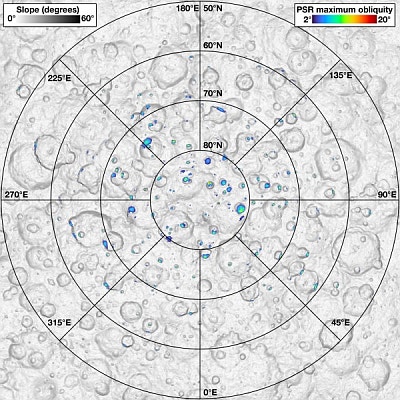Scientists: Any ice trapped in Ceres’ permanently shadowed craters has to be very young

The permanently shadowed craters (blue) at Ceres’
north pole. Click for original image.
Scientists reviewing the archive data from the Dawn probe that orbited the asteroid Ceres from 2016 to 2018 have found that the permanently shadowed craters at the asteroid’s poles are periodically exposed to sunlight due to long term variations in Ceres’ orbit, meaning that any of the ice in those craters detected by Dawn must be extremely young.
When Ceres reaches its maximum axis tilt, which last occurred about 14,000 years ago, no crater on Ceres remains perennially shadowed and any ice in them must have quickly sublimated into space. “That leaves only one plausible explanation: The ice deposits must have formed more recently than that. The results suggest all of these ice deposits must have accumulated within the last 6,000 years or less. Considering that Ceres is well over 4 billion years old, that is a remarkably young age,” Schorghofer said.
This does not mean that Ceres doesn’t have ice. In fact, it is very ice rich, below the surface. This data instead suggests that the surface remains active, and that there are processes bringing that underground ice to the surface on a regular basis. Except for these craters, which remain permanently shadowed for long time spans, that ice sublimates away relatively quickly. This result fits with earlier data from Dawn, that suggested many active locations on the surface, including its most distinct crater, Occator.
On Christmas Eve 1968 three Americans became the first humans to visit another world. What they did to celebrate was unexpected and profound, and will be remembered throughout all human history. Genesis: the Story of Apollo 8, Robert Zimmerman's classic history of humanity's first journey to another world, tells that story, and it is now available as both an ebook and an audiobook, both with a foreword by Valerie Anders and a new introduction by Robert Zimmerman.
The print edition can be purchased at Amazon or from any other book seller. If you want an autographed copy the price is $60 for the hardback and $45 for the paperback, plus $8 shipping for each. Go here for purchasing details. The ebook is available everywhere for $5.99 (before discount) at amazon, or direct from my ebook publisher, ebookit. If you buy it from ebookit you don't support the big tech companies and the author gets a bigger cut much sooner.
The audiobook is also available at all these vendors, and is also free with a 30-day trial membership to Audible.
"Not simply about one mission, [Genesis] is also the history of America's quest for the moon... Zimmerman has done a masterful job of tying disparate events together into a solid account of one of America's greatest human triumphs."--San Antonio Express-News

The permanently shadowed craters (blue) at Ceres’
north pole. Click for original image.
Scientists reviewing the archive data from the Dawn probe that orbited the asteroid Ceres from 2016 to 2018 have found that the permanently shadowed craters at the asteroid’s poles are periodically exposed to sunlight due to long term variations in Ceres’ orbit, meaning that any of the ice in those craters detected by Dawn must be extremely young.
When Ceres reaches its maximum axis tilt, which last occurred about 14,000 years ago, no crater on Ceres remains perennially shadowed and any ice in them must have quickly sublimated into space. “That leaves only one plausible explanation: The ice deposits must have formed more recently than that. The results suggest all of these ice deposits must have accumulated within the last 6,000 years or less. Considering that Ceres is well over 4 billion years old, that is a remarkably young age,” Schorghofer said.
This does not mean that Ceres doesn’t have ice. In fact, it is very ice rich, below the surface. This data instead suggests that the surface remains active, and that there are processes bringing that underground ice to the surface on a regular basis. Except for these craters, which remain permanently shadowed for long time spans, that ice sublimates away relatively quickly. This result fits with earlier data from Dawn, that suggested many active locations on the surface, including its most distinct crater, Occator.
On Christmas Eve 1968 three Americans became the first humans to visit another world. What they did to celebrate was unexpected and profound, and will be remembered throughout all human history. Genesis: the Story of Apollo 8, Robert Zimmerman's classic history of humanity's first journey to another world, tells that story, and it is now available as both an ebook and an audiobook, both with a foreword by Valerie Anders and a new introduction by Robert Zimmerman.
The print edition can be purchased at Amazon or from any other book seller. If you want an autographed copy the price is $60 for the hardback and $45 for the paperback, plus $8 shipping for each. Go here for purchasing details. The ebook is available everywhere for $5.99 (before discount) at amazon, or direct from my ebook publisher, ebookit. If you buy it from ebookit you don't support the big tech companies and the author gets a bigger cut much sooner.
The audiobook is also available at all these vendors, and is also free with a 30-day trial membership to Audible.
"Not simply about one mission, [Genesis] is also the history of America's quest for the moon... Zimmerman has done a masterful job of tying disparate events together into a solid account of one of America's greatest human triumphs."--San Antonio Express-News

